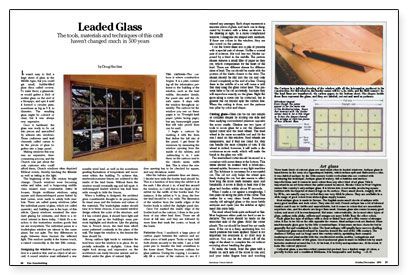Leaded Glass
The tools, materials and techniques of this craft haven't changed much in 500 years.

Synopsis: A thorough guide to making traditional leaded-glass windows. The author covers all phases of the job, from layout and template making to cutting glass and sealing the finished window with pigmented cement. It’s a lot of work but a window made this way, the author says, should last for 500 years.
It wasn’t easy to find a large sheet of glass in the Middle Ages, but you could get small, bubble-filled glass discs called crowns. To make them, a glassmaker would gather a blob of molten glass on the end of a blowpipe, and spin it until it formed a circular plate, sometimes as big as 5 ft. in diameter. The resulting glass might be colored or clear, but it was always very expensive.
Once it hardened, the glass was ready to be cut into pieces and assembled by artisans into windows. These craftsmen used lead channels called cames to tie the pieces of glass together into a large panel.
Making windows this way was an expensive, time-consuming process, and the Church was just about the only customer who could afford them. Church windows often depicted Biblical events, thereby teaching the illiterate as well as letting in the light.
The beginning of the 15th century brought change. Church windows were becoming wider and taller, and a burgeoning middle class wanted more comfortable, better lit houses. Simple rectilinear windows, using square and diamond-shaped panes linked by lead cames, were made to satisfy both markets. These are called quarry windows (after the individual panes of glass, which are called quarrels), and building one is the topic of this article. Quarry windows remained the standard glazing for centuries, and there is a revived interest in them today. I think it’s a reaction to the textureless modern goods that we see everywhere. The individual panes in a leaded-glass window are almost in the same plane, but not quite. The tiny differences in angle between them fracture the reflected light. This random quality is the human touch, a valued commodity in the late 20th century.
Designing the window
A good leaded window is a window first, and an object of art second. A sound window must withstand a reasonable wind load, as well as the sometimes grueling fluctuations of temperature and movement within the building. To achieve this, steel-reinforcement braces are soldered to the inside of the lead frame. Without them the window would eventually sag and fall apart. A well-designed leaded window has lead lines wide enough to hide the braces.
When a building is designed, the architect gives considerable thought to its proportions, its visual mass and the textures and values of the materials. The leaded-glass maker should tune in to these choices. A successful window design reflects the scale of the structure, and if it has colored glass, it should have light and dark areas, just as the building’s mass presents highlights and shadows. Like the glazing bars in French doors, the lead lines afford some patterned continuity in the plane of the wall. The larger the window is, the heavier the lines should be.
Strong outdoor light tends to minimize the lead lines once the window is in place. It’s especially noticeable in skylights. Colors that might look strong and expressive on the workbench can easily become anemic and indistinct under the glare of natural light.
For more photos, drawings, and details, click the View PDF button below:


























